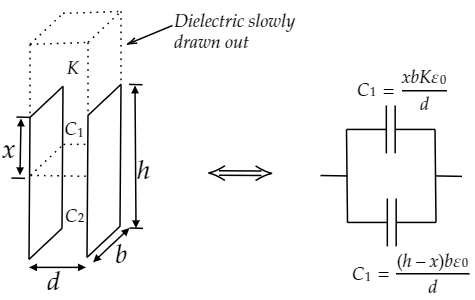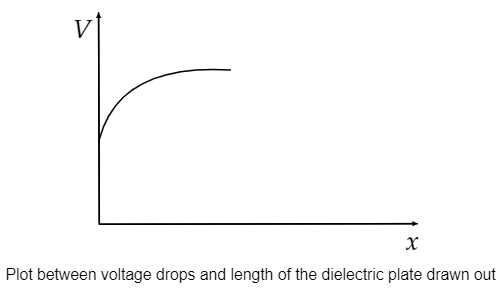
Between the plates of a parallel plate capacitor a dielectric plate is introduced just to fill the space between the plates. The capacitor is charged and later disconnected from the battery. The dielectric plate is slowly drawn out of the capacitor parallel to the plates. The plot of the potential difference across the plates and the length of the dielectric plate drawn out is:
Answer
477.3k+ views
Hint: When a parallel plate capacitor is filled up with a dielectric material, its capacitance will be increased by $K$ times. Where, $K$ is the dielectric constant of the given dielectric material.
The voltage drop across the capacitor is inversely proportional to its capacitance. If capacitance increases voltage drops across the capacitor decreases and vice versa.
Complete step by step solution:
When a parallel plate capacitor is filled with free space, its capacitance $C = \dfrac{{{\varepsilon _0}A}}{d}$.
Where, ${\varepsilon _0}$ is the electric permittivity of free space
$A$ is the surface area of a plate of the capacitor
$d$ is the distance between the two parallel plates of the capacitor.
Let $h$ and $b$ are the height and base of each parallel plate of the capacitor.
When the capacitor is filled with dielectric material having the dielectric constant $K$, its capacitance will become ${C_K} = \dfrac{{K{\varepsilon _0}A}}{d}$.
Now the capacitor filled with dielectric is charged and then disconnected from the battery. The dielectric material is slowly drawn out of the capacitor parallel to the plates.
We can consider this situation as two capacitors ${C_1}$ and ${C_2}$ connected in parallel. Where ${C_1}$ is filled with dielectric and ${C_2}$ is filled with free space.

Let $x$ is the height of the parallel plates of the capacitor ${C_1}$ filled with given dielectric material.
Then the height of the parallel plates of the capacitor ${C_2}$ is $\left( {h - x} \right)$.
Surface area of a parallel plate of ${C_1}$ is ${A_1} = x \cdot b$
The capacitance ${C_1} = \dfrac{{xbK{\varepsilon _0}}}{d}$.
In the same way, ${A_2} = \left( {h - x} \right)b$
And ${C_2} = \dfrac{{\left( {h - x} \right)b{\varepsilon _0}}}{d}$.
The total capacitance of the two capacitors connected in parallel is
${C_T} = {C_1} + {C_2}$
Substitute the values of ${C_1}$ and ${C_2}$ in the above formula.
$ \Rightarrow {C_T} = \dfrac{{xbK{\varepsilon _0}}}{d} + \dfrac{{\left( {h - x} \right)b{\varepsilon _0}}}{d}$
Further simplifying
$ \Rightarrow {C_T} = b{\varepsilon _0}\dfrac{{\left[ {h + \left( {K - 1} \right)x} \right]}}{d}$
We know that the voltage drops $\left( V \right)$ across a capacitor is the ratio of charge \[\left( q \right)\] and capacitance of the capacitor $\left( {{C_T}} \right)$.
Voltage drops $V = \dfrac{q}{{{C_T}}}$
Substitute the value of ${C_T}$ in the above formula
$ \Rightarrow V = \dfrac{{qd}}{{\left[ {h + \left( {K - 1} \right)x } \right]b{\varepsilon _0}}}$
So, when the dielectric material is slowly drawn out from the capacitor, $x$ decreases and the voltage drops. After complete removal of dielectric material from the capacitor, the voltage drops across the capacitor will become constant.
So, the graph between voltage drops and length of the dielectric plate drawn out is as follows.

Note:
It should be noted that the total charge of the capacitor remains constant. When the two capacitors are connected in parallel, its effective capacitance will be the sum of capacitance of each capacitor.
The dielectric constant for a given material is the ratio of permittivity of the material to the permittivity of free space. The dielectric constant is also known as relative permittivity.
The voltage drop across the capacitor is inversely proportional to its capacitance. If capacitance increases voltage drops across the capacitor decreases and vice versa.
Complete step by step solution:
When a parallel plate capacitor is filled with free space, its capacitance $C = \dfrac{{{\varepsilon _0}A}}{d}$.
Where, ${\varepsilon _0}$ is the electric permittivity of free space
$A$ is the surface area of a plate of the capacitor
$d$ is the distance between the two parallel plates of the capacitor.
Let $h$ and $b$ are the height and base of each parallel plate of the capacitor.
When the capacitor is filled with dielectric material having the dielectric constant $K$, its capacitance will become ${C_K} = \dfrac{{K{\varepsilon _0}A}}{d}$.
Now the capacitor filled with dielectric is charged and then disconnected from the battery. The dielectric material is slowly drawn out of the capacitor parallel to the plates.
We can consider this situation as two capacitors ${C_1}$ and ${C_2}$ connected in parallel. Where ${C_1}$ is filled with dielectric and ${C_2}$ is filled with free space.

Let $x$ is the height of the parallel plates of the capacitor ${C_1}$ filled with given dielectric material.
Then the height of the parallel plates of the capacitor ${C_2}$ is $\left( {h - x} \right)$.
Surface area of a parallel plate of ${C_1}$ is ${A_1} = x \cdot b$
The capacitance ${C_1} = \dfrac{{xbK{\varepsilon _0}}}{d}$.
In the same way, ${A_2} = \left( {h - x} \right)b$
And ${C_2} = \dfrac{{\left( {h - x} \right)b{\varepsilon _0}}}{d}$.
The total capacitance of the two capacitors connected in parallel is
${C_T} = {C_1} + {C_2}$
Substitute the values of ${C_1}$ and ${C_2}$ in the above formula.
$ \Rightarrow {C_T} = \dfrac{{xbK{\varepsilon _0}}}{d} + \dfrac{{\left( {h - x} \right)b{\varepsilon _0}}}{d}$
Further simplifying
$ \Rightarrow {C_T} = b{\varepsilon _0}\dfrac{{\left[ {h + \left( {K - 1} \right)x} \right]}}{d}$
We know that the voltage drops $\left( V \right)$ across a capacitor is the ratio of charge \[\left( q \right)\] and capacitance of the capacitor $\left( {{C_T}} \right)$.
Voltage drops $V = \dfrac{q}{{{C_T}}}$
Substitute the value of ${C_T}$ in the above formula
$ \Rightarrow V = \dfrac{{qd}}{{\left[ {h + \left( {K - 1} \right)x } \right]b{\varepsilon _0}}}$
So, when the dielectric material is slowly drawn out from the capacitor, $x$ decreases and the voltage drops. After complete removal of dielectric material from the capacitor, the voltage drops across the capacitor will become constant.
So, the graph between voltage drops and length of the dielectric plate drawn out is as follows.

Note:
It should be noted that the total charge of the capacitor remains constant. When the two capacitors are connected in parallel, its effective capacitance will be the sum of capacitance of each capacitor.
The dielectric constant for a given material is the ratio of permittivity of the material to the permittivity of free space. The dielectric constant is also known as relative permittivity.
Recently Updated Pages
Master Class 12 Business Studies: Engaging Questions & Answers for Success

Master Class 12 Economics: Engaging Questions & Answers for Success

Master Class 12 English: Engaging Questions & Answers for Success

Master Class 12 Maths: Engaging Questions & Answers for Success

Master Class 12 Social Science: Engaging Questions & Answers for Success

Master Class 12 Chemistry: Engaging Questions & Answers for Success

Trending doubts
What are the major means of transport Explain each class 12 social science CBSE

Which are the Top 10 Largest Countries of the World?

Draw a labelled sketch of the human eye class 12 physics CBSE

Explain sex determination in humans with line diag class 12 biology CBSE

The pH of the pancreatic juice is A 64 B 86 C 120 D class 12 biology CBSE

Explain sex determination in humans with the help of class 12 biology CBSE




